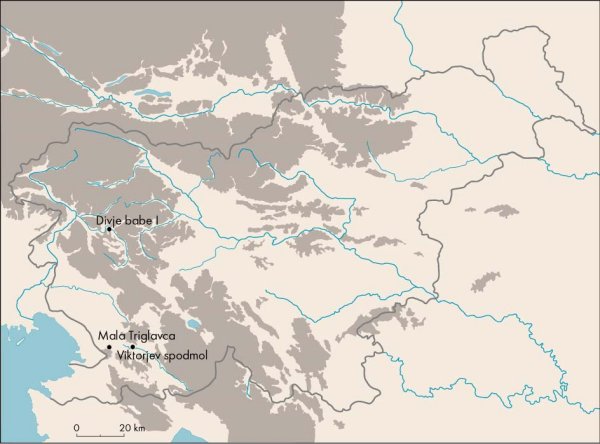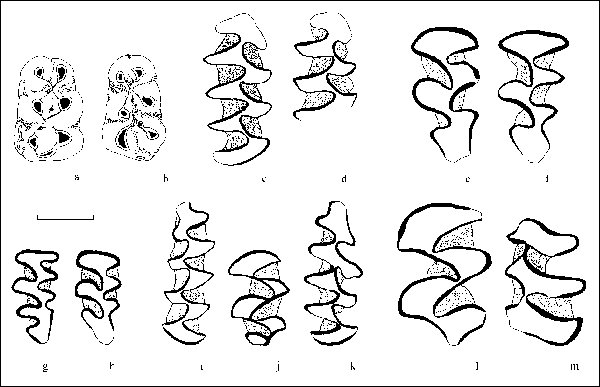|
ARCHAEOZOOLOGY
Basic information | Recent publications
RESEARCH
Small mammals from Upper Pleistocene and Early Holocene of Western Slovenia

Map of Slovenia with Divje babe I , Viktorjev spodmol and Mala Triglavca.
The object of the study were small terrestrial mammals (Soricomorpha,
Chiroptera, Rodentia) from Upper Pleistocene cave site of Divje babe I and from
layers of Mesolithic age at Viktorjev spodmol and Mala Triglavca rock shelters.
Several thousand specimens, belonging to a minimum of 31 species were
identified. Noteworthy records include Sicista subtilis (ca. 80-75 ky BP) from
Divje babe I and Cricetulus migratorius (ca. 9600-6000 y BP) from Viktorjev
spodmol and Mala Triglavca, being reported for the first time in this part of
Europe. The discovery of Dinaromys bogdanovi in Mesolithic layers at Viktorjev
spodmol and Mala Triglavca are the first Holocene records outside the recent
range of the species.

Molars of hamsters (Cricetinae) and voles (Arvicolinae) from Viktorjev spodmol.
On the basis of small mammal assemblage from Divje babe I, the climate
indicated for OIS 5a-5d was presumably temperate and relatively dry, with
prevalence of open habitats over prevalently coniferous forest. In the OIS 3 the
climate was more humid and the habitat was presumably a mosaic of mixed,
predominantly coniferous forest, with meadows and accumulations of rocky
boulders. On the basis of micromammal remnants of Viktorjev spodmol and Mala
Triglavca the habitat in the Early Holocene was presumably of mixed forest with
relatively limited open areas (i.e. meadows, rocky boulders). Furthermore, it
was discovered that small mammal faunas present on the southern border of the
Alpine glacier during OIS 5 and OIS 3 were only slightly different from those
found in the same area in the Holocene, both of them already including forest
-dwelling mammals (G. glis, A. flavicollis, C. glareolus, S. vulgaris, Sorex
spp.). For this reason the Upper Pleistocene small mammal fauna of Divje babe I
resembles the modern fauna from the same area more than it does the contemporary
communities from Central Europe, where the rapid turnover in the rodent
assemblages (i.e. replacement of boreal and steppe species with forest-dwellers)
took place as late as at the Pleistocene – Holocene boundary.
Relevant publications
- TOŠKAN, Borut, DIRJEC, Janez, BAVDEK, Alma. Lost in time? : repatriated animal remains from Anelli's excavations at Betalov spodmol (SW Slovenia) = Izgubljeni v času? : živalski ostanki z Anellijevih izkopavanj v Betalovem spodmolu pri Postojni. RMZ - Materials and geoenvironment, 2014, 61, (2/3), str. 143-157.
- TOŠKAN, Borut, DIRJEC, Janez. Velike podnebne spremembe razkrite na podlagi malih fosilov : Nekdanje okolje na meji med zgodnjim in srednjim würmom v okolici Divjih bab I = Big climatic changes revealed by tiny fossils : palaeoenvironment at the boundary between the Early and Middle Würm in the surroundings of Divje babe I. In: TOŠKAN, Borut (ed.). Drobci ledenodobnega okolja : zbornik ob življenjskem jubileju Ivana Turka = Fragments of ice age environments : proceedings in honour of Ivan Turk's jubilee, (Opera Instituti Archaeologici Sloveniae, 21). Ljubljana: Inštitut za arheologijo ZRC SAZU, Založba ZRC, 2011, str. 155-179.
- TOŠKAN, Borut. Small terrestrial mammals (Soricomorpha, Chiroptera, Rodentia) from the early Holocene layers of Mala Triglavca (SW Slovenia) = Mali terestični sesalci (Soricomorpha, Chiroptera, Rodentia) iz zgodnjeholocenskih plasti Male Triglavce (JZ Slovenija). Acta carsol., 2009, letn. 38, št. 1, str. 117-133, ilustr. [COBISS.SI-ID 29917485]
- TOŠKAN, Borut, KRYŠTUFEK, Boris. Ostanki malih sesalcev v Viktorjevem spodmolu (Insectivora, Chiroptera, Mammalia) = Small mammals in Viktorjev spodmol (Insectivora, Chiroptera, Mammalia). V: TURK, Ivan (ur.), OVSENIK, Maja, TURK, Ivan. Viktorjev spodmol in Mala Triglavca : prispevki k poznavanju mezolitskega obdobja v Sloveniji : contributions to understanding the Mesolithic period in Slovenia, (Opera Instituti archaeologici Sloveniae, 9). Ljubljana: Inštitut za arheologijo ZRC SAZU: = Institute of archaeology at ZRC SAZU: Založba ZRC: = ZRC Publishing, 2004, str. 114-134, ilustr. [COBISS.SI-ID 22789933]
- TOŠKAN, Borut, KRYŠTUFEK, Boris. Noteworthy rodent records from the upper pleistocene and holocene of Slovenia. Mammalia (Paris), 2006, vol. 70, iss. 1/2, str. 98-105
<< Research | Top | >> Large mammals
|
 Institute of Archaeology
Institute of Archaeology
